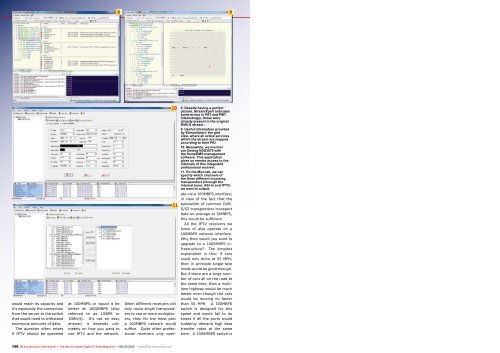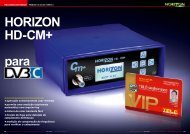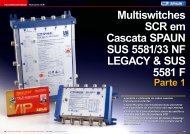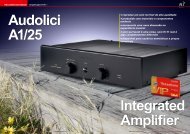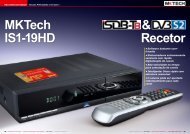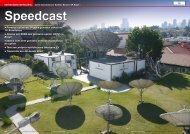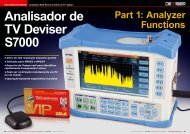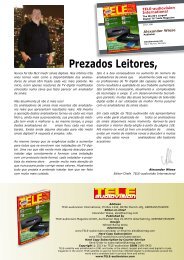TV a partir de uma rede
Create successful ePaper yourself
Turn your PDF publications into a flip-book with our unique Google optimized e-Paper software.
would reach its capacity and<br />
it‘s especially the connection<br />
from the server to the switch<br />
that would need to withstand<br />
enormous amounts of data.<br />
The question often arises<br />
if IP<strong>TV</strong> should be operated<br />
at 100MBPS or would it be<br />
better at 1000MBPS (also<br />
referred to as 1GBPS or<br />
1GBit/s). It‘s not an easy<br />
answer; it <strong>de</strong>pends ultimately<br />
on how you want to<br />
use IP<strong>TV</strong> and the network.<br />
158 TELE-audiovision International — The World‘s Largest Digital <strong>TV</strong> Tra<strong>de</strong> Magazine — 09-10/2013 — www.TELE-audiovision.com<br />
8 9<br />
10<br />
11<br />
When different receivers will<br />
only route single transpon<strong>de</strong>rs<br />
to one or more multiplexers,<br />
then for the most part<br />
a 100MBPS network would<br />
suffice. Quite often professional<br />
receivers only oper-<br />
8. Despite having a perfect<br />
picture, StreamXpert indicates<br />
some errors in PAT and PMT.<br />
Interestingly; these were<br />
already present in the original<br />
DVB-S stream…<br />
9. Useful information provi<strong>de</strong>d<br />
by StreamXpert: the grid<br />
view, where all active services<br />
within the stream are mapped<br />
according to their PID.<br />
10. Meanwhile, we monitor<br />
our Dexing NDS3975 with<br />
the SnmpNMS management<br />
software. This application<br />
gives us remote access to the<br />
internals of this integrated<br />
professional receiver.<br />
11. On the Mux-tab, we can<br />
specify which channels of<br />
the three different incoming<br />
transpon<strong>de</strong>rs (through the<br />
internal tuner, ASI-in and IP<strong>TV</strong>)<br />
we want to output.<br />
ate via a 100MBPS interface;<br />
in view of the fact that the<br />
bandwidth of common DVB-<br />
S/S2 transpon<strong>de</strong>rs transport<br />
data on average at 50MBPS,<br />
this would be sufficient.<br />
All the IP<strong>TV</strong> receivers we<br />
know of also operate on a<br />
100MBPS network interface.<br />
Why then would you want to<br />
upgra<strong>de</strong> to a 1000MBPS infrastructure?<br />
The simplest<br />
explanation is this: if cars<br />
could only drive at 55 MPH,<br />
then in principle single-lane<br />
roads would be good enough.<br />
But if there are a large number<br />
of cars all on the road at<br />
the same time, then a multilane<br />
highway would be much<br />
better even though the cars<br />
would be moving no faster<br />
than 55 MPH. A 100MBPS<br />
switch is <strong>de</strong>signed for this<br />
speed and would fall to its<br />
knees if all the ports would<br />
sud<strong>de</strong>nly <strong>de</strong>mand high data<br />
transfer rates at the same<br />
time. A 1000MBPS switch is


